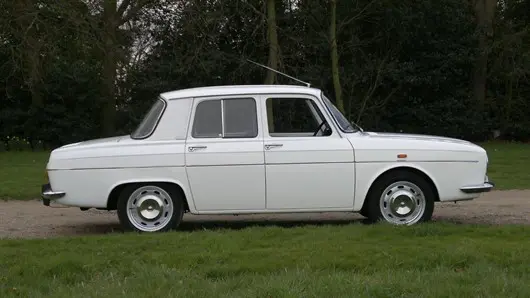OWNER’S PROFILE – JAMES ROSS SINCLAIR AND HIS RENAULT 10
22 November 2018
The Renault 8 and 10 used to be one of the most commonly encountered rear-engine cars in the UK and their owners would proudly boast about their comfort, their reliability and such features as disc braking on all four wheels.
The original 8 debuted in 1962 - - and the long-nosed 1.1 litre 10 in 1965 and in France they competed against both Simca’s 1000 and such FWD rivals as the Citroën Ami 6 and, in the late 1960s, the Peugeot 204 -
The debut of the front wheel drive 12 in 1969 marked the end of the company’s tradition of rear engine saloons that dated back to the 4CV of 1947. The 8 ceased production in 1973 (although the Spanish plant was still building them as late as 1976) and the 10 in 1971.
The latter was marketed in the USA under the jaw-dropping slogan ‘If a car doesn’t have to be an extension of your manhood’. The sales copy proceeding to state that ‘no amount of bulging chrome, 5 or 6 on the floor, or overhead cams has ever turned a milksop into Atilla the Hun’ The Renault 10 is for men who don’t need a crutch’.
Meanwhile, Renault dealers in the UK offered the 10 - known as the “1100” - as an alternative to the BMC ADO16, Hillman Imp or Vauxhall Viva. A Motor test of 1965 observed that although the French import was comparatively expensive at £700 ‘we cannot recall another small saloon that travels more smoothly and quietly’. Today a well-presented 10 is more exclusive sight than an Alpine A310 – which makes the magnificent 1969 example owned by James Ross Sinclair a most exclusive motor car.
He acquired his Renault in 2013 ‘sight unseen’ from eBay – ‘I’d owned an R8 years ago that I paid peanuts for. The R8/10 get under your skin..’ and when his acquisition arrived on the back of a lorry James found ‘ it was in a ‘near immaculate condition’. Since then ‘I've since painted it not once but twice to ensure everything was hunky dory’ and he remarks how enjoyable the 10 is to own:
They are very endearing to drive. First, the exceptionally long-lived “Cléon-Fonte” engine is very eager and almost turbine smooth. Married to the light weight of the car it makes for a very nippy drive - it just wants to go and go. It's hard to explain, but I feel very affectionate towards my R10 (aka La Regie) because it is just such good fun to drive. You have to keep an eye on the tyre pressures to keep the handling ok, and mine has had a little mod at the rear to tame the infamous swing axle design.
The only real fault is their tendency to wander unladen in cross winds - the handling is not half as evil as most rear-engined cars and superior to many VW's I've owned. Disc brakes all round are another novelty and reassuringly good, though they take a fair amount of maintenance to keep going...
Regarding the coachwork, Mr. Sinclair views the Renault’s distinctively boxy lines that give it the same utilitarian air as a 1960s government office building as ‘an R8 with a nose and bum job’. If you craved an ethos of glamour and excitement combined with quite reasonable fuel economy, there was always the Caravelle, while the 10 was aimed at the practically minded individualist.
‘The almost comical overhangs do however make for an exceptionally roomy boot at the front (not many rear engine small cars you can fit a pedal cycle in), and the extra weight over the front wheels is very welcome’.
As with any great Renault of this era, the 10’s interior is a blend of the Spartan and the surprisingly comfortable. The sliding rear windows were a trademark of its Dauphine and 4CV predecessors while the seats ‘ are in the typical French squishy class and are exceptionally comfortable’.
One minor issue is exit and egress – the four-door layout was a selling point in the 1960s and early 1970s but ‘it only occurred to me the other day they are so narrow they basically take up the space of most two-door cars!’.
And perhaps most importantly, the Sinclair 10 can instantly evoke the past, especially for those of us whose family owned a Renault - indeed, mine had a 1964 8. The switchgear that is apparently placed at random, the volcanic heater that seemed to be designed to roast the passenger’s ankles and the sound of the motor clattering away are details of a car that you can never forget. As James reflects:
My love of these cars dates back to a 1970s childhood when you still saw them running about - often as second cars or bargain basement transport. Two things stick in my mind - the kind of exhaust noise that you really only get from rear-engined cars with one foot of silencer... and the almost childlike styling - or 'backwards forwards looking' as my dear old dad used to say.

